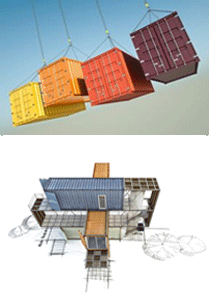- Home
- Building
- Transportation
- Dimensions
- Container Costs
- Used Containers
- 20 FOOT
- Book Store
- Container Sizes
- Companies
- Manufacturers
- Plans
- Drawings
- Used For Sale
- Projects
- Carriers
- Green House
- Benefits
- Construction
- Origins
- Design
- Specs
- Industry
- Refrigerated
- Cranes
- Open Tops
- Intermodal
- Insulated
- History
- Articles
- SCH Blog
- Contact us
- Submit your site
- Suggestions
- Privacy Policy
Container Living: Some Villain Thoughts About a Container Village
by Iulia Pascau, Romania
I read a few articles about container living or 'shipping container housing'. It took me about five minutes to realize this subject makes your mind frolic endlessly on an imaginary (however not utopian) land. Those articles belong to some very respectable gentlemen (at least that was the impression they made on me, at first reading) – that praise living in shipping containers.
Let's go cheap.
A 40 foot-long shipping container could reach to $1,500-2,000. I started asking myself questions about how container living could become a solution for homeless people in Romania (that's where I live), whereflats cost (at least) $20,000. And they're not 40 foot-long.
At the same time, Romania has a lot of peripheral categories: the poor, the old, the young, the unemployed, the pitman, the gypsy, the orphan, the student.
Could they benefit from this recent discovery that living in some kind of shoe-boxes can be really cool and trendy? I'll try to answer that.
A few advantages of container living from a Romanian point of view: for peripherals it's cheap, for artists it's unconventionalthe subject is quite green you can "camp" anywhere you want (Romania has not few spectacular landmarks)the result you get using shipping containers can be anywhere between "plastic" and "platinum", practical and fantasy, serious and ludic - you can move your "house" around. At least that's what LOT/EK people are trying to prove by their "mobile dwelling unit" project. Earthquakes, floods and sliding land are some serious problems in Romania, so being able to leave the place at a snail's pace may be useful.
- Most Romanians live in blocks of flats that pretty much look like overcrowded shipping containers (and usually inadequate to modern standards: water supply, heating, insulation, comfort etc). Could container actually mean a reasonable escape? Maybe, if they are properly transformed and adapted to living conditions.
- A sad fact is that few Romanians actually have the possibility to pay $2,000 cash for a house-to-be.
If you are not a Romanian 2007 could be, in the optimist version, the year that Romania will join EU. Compared to Western standards, Romanian land properties are very cheap. Land-purchase conditions are the same for both Romanians and foreigners.
A few observations to Mr Doug Casey's reportage about his Romanian adventure (www.escapeartist.com/efam17/Romania.html).
Given the reasons Mr. Casey liked Romania, I quickly made some "counts". The average Romanian needs to work (at a medium economy salary rate of $11 per day) 2272 days to buy an apartment; or, 103 months (I excluded weekend days of course, they don't pay); or 9 years. This without considering any interest. And supposing that this particular individual doesn't eat, dress or pay rent.
Just work his butt off. In real terms, he needs more than nine years, probably 25. That's pretty much for an average ephemeride that lives an average 75 years life.
Mr. Casey's mentioning of the brief trial and execution of the Ceausescu couple has suddenly brought to my senses a smell of a Dogville atmosphere that I have never before associated with Romania. Of course, I'm talking about the movie dog-ville, not the real one.
That takes me back to the initial idea that container living is a subject that gives you some chalk drawn-squares (or parallelepipeds in our case) that make you want to play like kids do with their Lego pieces.
But here are a few more questions:
Where do you find those imaginative grown-ups that are able to play with shipping containers in a coherent / artful manner?
What would their work be worth in the end?
How much do utilities cost (water, energy, gas supply etc.)?
Would the authorities be open to hear this as an alternative solution to traditional housing?
Iulia Pascanu
Iulia Pascanu contributes articles on container living
